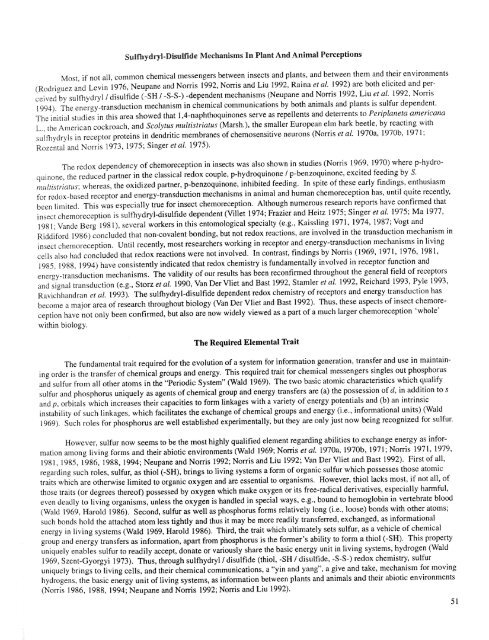View or print this publication - Northern Research Station - USDA ...
View or print this publication - Northern Research Station - USDA ...
View or print this publication - Northern Research Station - USDA ...
You also want an ePaper? Increase the reach of your titles
YUMPU automatically turns print PDFs into web optimized ePapers that Google loves.
Sulfhydryl-Disulfide Mechanisms In Plant And Animal Perceptions<br />
Most, if not all, common chemical messengers between insects and plants, and between them and their environments<br />
(Rodriguez and Levin 1976, Neupane and N<strong>or</strong>ris 1992, N<strong>or</strong>ris and Liu 1992, Raina et al. 1992) are both elicited and perceived<br />
by sulfhydryl / disulfide (-SH / -S-S-) -dependent mechanisms (Neupane and N<strong>or</strong>ris 1992, Liu et al. 1992, N<strong>or</strong>ris<br />
1994). The energy-transduction mechanism in chemical communications by both animals and plants is sulfur dependent.<br />
The initial studies in <strong>this</strong> area showed that 1,4-naphthoquinones serve as repellents and deterrents to Periplaneta americana<br />
L., the American cockroach, and Scolytus multistriatus (Marsh.), the smaller European elm bark beetle, by reacting with<br />
sulfhydryls in recept<strong>or</strong> proteins in dendritic membranes of chemosensitive neurons (N<strong>or</strong>ris et al. 1970a, 1970b, 1971;<br />
Rozental and N<strong>or</strong>ris 1973, 1975; Singer et al. 1975).<br />
The redox dependency of chem<strong>or</strong>eception in insects was also shown in studies (N<strong>or</strong>ris 1969, 1970) where p-hydroquinone,<br />
the reduced partner in the classical redox couple, p-hydroquinone / p-benzoquinone, excited feeding by S.<br />
multistriatus; whereas, the oxidized partner, p-benzoquinone, inhibited feeding. In spite of these early findings, enthusiasm<br />
f<strong>or</strong> redox-based recept<strong>or</strong> and energy-transduction mechanisms in animal and human chem<strong>or</strong>eception has, until quite recently,<br />
been limited. This was especially true f<strong>or</strong> insect chem<strong>or</strong>eception. Although numerous research rep<strong>or</strong>ts have confirmed that<br />
insect chem<strong>or</strong>eception is sulfhydryl-disulfide dependent (Villet 1974; Frazier and Heitz 1975; Singer et al. 1975; Ma 1977,<br />
1981; Vande Berg 1981), several w<strong>or</strong>kers in <strong>this</strong> entomological specialty (e.g., Kaissling 1971, 1974, 1987; Vogt and<br />
Riddifbrd 1986) concluded that non-covalent bonding, but not redox reactions, are involved in the transduction mechanism in<br />
insect chern<strong>or</strong>eception. Until recently, most researchers w<strong>or</strong>king in recept<strong>or</strong> and energy-transduction mechanisms in living<br />
cells also had concluded that redox reactions were not involved. In contrast, findings by N<strong>or</strong>ris (1969, 1971, 1976, 1981,<br />
1985, 1988, 1994) have consistently indicated that redox chemistry is fundamentally involved in recept<strong>or</strong> function and<br />
energy-transduction mechanisms. The validity of our results has been reconfirmed throughout the general field of recept<strong>or</strong>s<br />
and signal transduction (e.g., St<strong>or</strong>z et al. 1990, Van Der Vliet and Bast 1992, Stamler et al. 1992, Reichard 1993, Pyle 1993,<br />
Ravichhandran et al. 1993). The sulfhydryl-disulfide dependent:redox chemistry of recept<strong>or</strong>s and energy transduction has<br />
become a maj<strong>or</strong> area of research throughout biology (Van Der Vliet and Bast 1992). Thus, these aspects of insect chem<strong>or</strong>eception<br />
have not only been confirmed, but also are now widely viewed as a part of a much larger chem<strong>or</strong>eception 'whole'<br />
within biology.<br />
The Required Elemental Trait<br />
The fundamental trait required f<strong>or</strong> the evolution of a system f<strong>or</strong> inf<strong>or</strong>mation generation, transfer and use in maintaining<br />
<strong>or</strong>der is the transfer of chemical groups and energy. This required trait f<strong>or</strong> chemical messengers singles out phosph<strong>or</strong>us<br />
and sulfur from all other atoms in the "Periodic System" (Wald 1969). The two basic atomic characteristics which qualify<br />
sulfur and phosph<strong>or</strong>us uniquely as agents of chemical group and energy transfers are (a) the possession of d, in addition to s<br />
and p, <strong>or</strong>bitals which increases their capacities to f<strong>or</strong>m linkages with a variety of energy potentials and (b) an intrinsic<br />
instability of such linkages, which facilitates the exchange of chemical groups and energy (i.e., inf<strong>or</strong>mational units) (Wald<br />
1969). Such roles f<strong>or</strong> phosph<strong>or</strong>us are well established experimentally, but they are only just now being recognized f<strong>or</strong> sulfur.<br />
However, sulfur now seems to be the most highly qualified element regarding abilities to exchange energy as inf<strong>or</strong>mation<br />
among living f<strong>or</strong>ms and their abiotic environments (Wald 1969; N<strong>or</strong>ris et al. 1970a, 1970b, 1971; N<strong>or</strong>ris 1971, 1979,<br />
1981, 1985, 1986, 1988, 1994; Neupane and N<strong>or</strong>ris 1992; N<strong>or</strong>ris and Liu 1992; Van Der Vliet and Bast 1992). First of all,<br />
regarding such roles, sulfur, as thiol (-SH), brings to living systems a f<strong>or</strong>m of <strong>or</strong>ganic sulfur which possesses those atomic<br />
traits which are otherwise limited to <strong>or</strong>ganic oxygen and are essential to <strong>or</strong>ganisms. However, thiol lacks most, if not all, of<br />
those traits (<strong>or</strong> degrees thereof) possessed by oxygen which make oxygen <strong>or</strong> its free-radical derivatives, especially harmful,<br />
even deadly to living <strong>or</strong>ganisms, unless the oxygen is handled in special ways, e.g., bound to hemoglobin in vertebrate blood<br />
(Wald 1969, Harold 1986). Second, sulfur as well as phosph<strong>or</strong>us f<strong>or</strong>ms relatively long (i.e., loose) bonds with other atoms;<br />
such bonds hold the attached atom less tightly and thus it may be m<strong>or</strong>e readily transferred, exchanged, as inf<strong>or</strong>mational<br />
energy in living systems (Wald 1969, Harold t986). Third, the trait which ultimately sets sulfur, as a vehicle of chemical<br />
group and energy transfers as inf<strong>or</strong>mation, apart from phosph<strong>or</strong>us is the f<strong>or</strong>mer's ability to f<strong>or</strong>m a thiol (-SH). This property<br />
uniquely enables sulfur to readily accept, donate <strong>or</strong> variously share the basic energy unit in living systems, hydrogen (Wald<br />
1969, Szent-Gy<strong>or</strong>gyi 1973). Thus, through sulfhydryl / disulfide (thiol, -SH / disulfide, -S-S-) redox chemistry, sulfur<br />
uniquely brings to living cells, and their chemical communications, a "yin and yang", a give and take, mechanism f<strong>or</strong> moving<br />
hydrogens, the basic energy unit of living systems, as inf<strong>or</strong>mation between plants and animals and their abiotic environments<br />
(N<strong>or</strong>ris 1986, 1988, 1994; Neupane and N<strong>or</strong>ris 1992; N<strong>or</strong>ris and Liu 1992).<br />
51
















